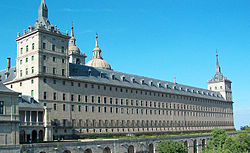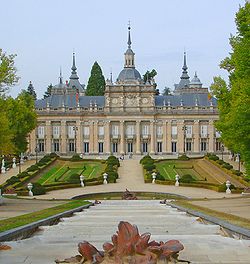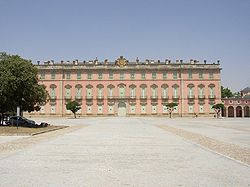
El Escorial, or the Royal Site of San Lorenzo de El Escorial, or Monasterio de El Escorial, is a historical residence of the King of Spain located in the town of San Lorenzo de El Escorial, 2.06 kilometres (1.28 mi) up the valley from the town of El Escorial and about 45 kilometres (28 mi) northwest of the Spanish capital Madrid. Built between 1563 and 1584 by order of King Philip II, El Escorial is the largest Renaissance building in the world. It is one of the Spanish royal sites and functions as a monastery, basilica, royal palace, pantheon, library, museum, university, school, and hospital.

San Lorenzo de El Escorial, also known as El Escorial de Arriba, is a town and municipality in the Community of Madrid, Spain, located to the northwest of the region in the southeastern side of the Sierra de Guadarrama, at the foot of Mount Abantos and Las Machotas, 47 kilometres (29 mi) from Madrid. It is head of the eponymous judicial party. The settlement is popularly called El Escorial de Arriba, to differentiate it from the neighbouring village of El Escorial, also known as El Escorial de Abajo.

El Escorial is a municipality in the Autonomous Community of Madrid, located 45 km (28 mi) northwest of the Spanish capital Madrid. It belongs to the comarca of Cuenca del Guadarrama. Its population in 2009 was 14,979.

The Royal Palace of Madrid is the official residence of the Spanish royal family at the city of Madrid, although now used only for state ceremonies. The palace has 135,000 m2 (1,450,000 sq ft) of floor space and contains 3,418 rooms. It is the largest functioning royal palace in Europe.

The Royal Sites are a set of palaces, monasteries, and convents built for and under the patronage of the Spanish monarchy. They are administered by Patrimonio Nacional (National Heritage), a Spanish state agency; most are open to the public, at least in part, except when they are needed for state or official events.

The Royal Palace of Aranjuez is one of the official residences of the Spanish royal family. It is located in the town of Aranjuez (Madrid), Spain. Established in the 16th century as a royal hunting lodge, the palace was built by order of Philip II. Under his reign it became one of four seasonal seats of the court along Rascafría, El Escorial and the Royal Alcázar of Madrid. The royal estate comprises a set of landscaped and ornate gardens and woodlands that house an extensive botanical collection.

San Ildefonso, La Granja, or La Granja de San Ildefonso, is a town and municipality in the Province of Segovia, in the Castile and León autonomous region of central Spain.

Juan de Herrera was a Spanish architect, mathematician and geometrician.

The Royal Palace of La Granja de San Ildefonso, known as La Granja, is an early 18th-century palace in the small town of San Ildefonso, located in the hills near Segovia and 80 kilometres (50 mi) north of Madrid, within the Province of Segovia in central Spain.
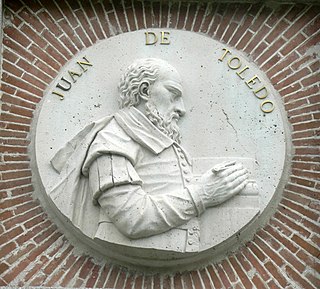
Juan Bautista de Toledo was a Spanish architect. He was educated in Italy, in the Italian High Renaissance. As many Italian renaissance architects, he had experience in both architecture and military and civil public works. Born, either in Toledo or in Madrid around 1515. He died on 19 May 1567 in Madrid, and was buried in Madrid in the choir of the primitive “Convento de Santo Tomás, Iglesia de la Santa Cruz”.

Juan de Villanueva was a Spanish architect. Alongside Ventura Rodríguez, Villanueva is the best known architect of Spanish Neoclassicism.

Luis de Vega was a 16th-century Spanish architect appointed royal architect of Charles I.

The Casita del Infante is a historic building in San Lorenzo de El Escorial, Spain. It was constructed as a private home for the Infante Gabriel of Spain, hence its name. The small residence was built in the late 18th century during the reign of his father, Charles III of Spain.

The Casita del Príncipe is an eighteenth-century building located in San Lorenzo de El Escorial, Spain. It was designed by the neoclassical architect Juan de Villanueva for the private use of the heir to the Spanish throne Charles, Prince of Asturias, and his wife Maria Luisa. It was constructed in the 1770s and extended in the 1780s.
The Royal Household and Heritage of the Crown of Spain was the institution that governed the organization of the Royal Spanish Court from the time of the Habsburg dynasty, which introduced the so-called Burgundian etiquette, up to the reign of Alfonso XIII, great-grandfather of the current King of Spain Felipe VI, in all that regarded the structure of the Court as well as the ceremonial matters, etiquette and protocol.
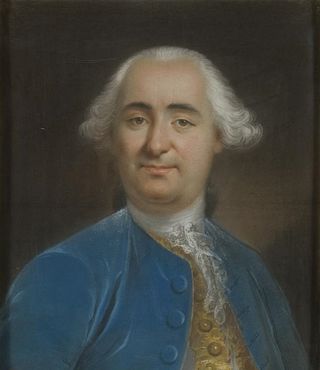
Jaime Marquet was a French architect who worked extensively in Bourbon Spain, and whose most important work includes the central plaza of Madrid known as Puerta del Sol and the adjacent monumental building, the Real Casa de Correos or Royal Mail Headquarters, now the offices of the President of the Community of Madrid.

The Casa del Labrador is a neoclassical palace in Aranjuez, Spain. The name means "house of the farm labourer", and was borrowed from an earlier building on the site, although the new building was intended for royal use. It was designed to complement the Royal Palace, providing a place for the royal family to spend the day without some of the customary restrictions of court life.
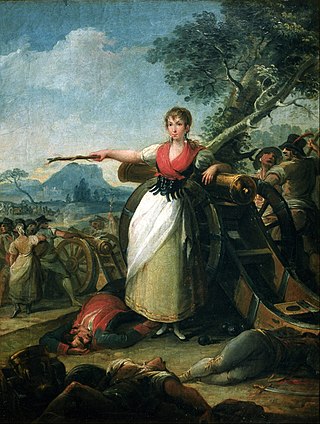
Juan Gálvez was a Spanish artist who served as court painter for King Ferdinand VII and Director of the Real Academia de Bellas Artes de San Fernando.
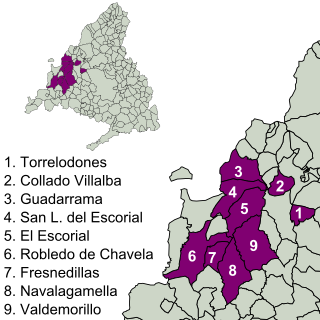
The Imperial Route of the Community of Madrid is the tourist itinerary promoted by the Ministry of Culture and Tourism of this Spanish region, which runs through several municipalities in the Sierra de Guadarrama. It partially follows the historical road that led to the Monastery of El Escorial, used in the 16th century by King Philip II in his travels from the city of Madrid to the Royal Site.


